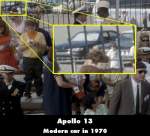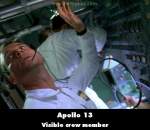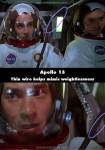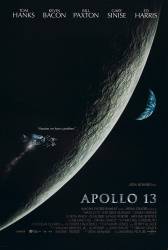
Factual error: During the launch sequence, a car that appears to be from the 1990's is parked in the background. (00:30:15)

Visible crew/equipment: Right after the explosion, Lovell tells Houston that they've got multiple cautions and warnings, and they've got to restart, then Swigert says, "I'm going to SCS," and he flips the switch. In the next wideshot of the trio, we can see the arm and fingers of a hidden crew member wearing a short sleeve blue shirt, who's holding up a hose at the bottom right corner of the screen. This is only visible in the fullscreen version. (00:51:20)
Factual error: In the movie, Henry tells a White House rep that Blackout lasts for 3 minutes, and if they are not back in 4, then they'll know they didn't survive. This is actually not correct. During the Apollo program, blackout typically lasted about 4 minutes. Also, Apollo 13's re-entry blackout in fact lasted 6 minutes, not 4 as seen in the movie, which was 87 seconds longer than predicted.
Factual error: When astronauts are wearing their spacesuits before launch, we can see NASA's "snake logo" introduced in 1975, when the plot is happening in 1970. (00:28:29)
Continuity mistake: The direction of the spacecraft keeps changing. After the extraction of the LM (Lunar Module), the craft is travelling with the CSM (Command/Service Module) engine bell facing forward. After the explosion, it is shown with the LM facing forward. Going around the moon, and back to earth, the CSM is again facing forward.
Suggested correction: The orientation of the spacecraft was not constant. There is no reason why it should be (and, indeed, good reason why it won't). Apollo 13 did indeed have the LM leading at some points and the CSM leading at others.
Factual error: On July 20, 1969, the moon phase was waxing crescent. In the movie, on the eve of the moon landing, the moon is shown in waxing gibbous phase when Lovell (Hanks) covers the moon with his thumb. (00:06:02)

Visible crew/equipment: During Marilyn Lovell's nightmare, the crew experiences cabin decompression. Right when the master alarm goes off, you see a piece of monofilament attached to Jim Lovell's suit hose, used to try and simulate zero G to make the hose appear to be floating. (00:13:20)
Continuity mistake: At the beginning of the "Failure Is Not an Option" scene, Gene writes "45 hrs" on the chalkboard. In the close-up as he writes it, the front of the 4 is curved into the spine, and the 5 is written with a flat top and flat back leading into the curve underneath. Then, Gene puts a period after "hrs." When the shot cuts wide, the 5 looks more like an S and the top of the five is curled back under. The spine of the 4 has become much longer as well. When Gene walks back to the board at the end of the scene, the front of the 4 is more angular than curved, and the 5 still looks like an S but the curl under the top line is gone. And, once the shot changes away from Gene writing it, the period after "hrs" disappears for the rest of the scene. (01:15:50 - 01:17:45)





